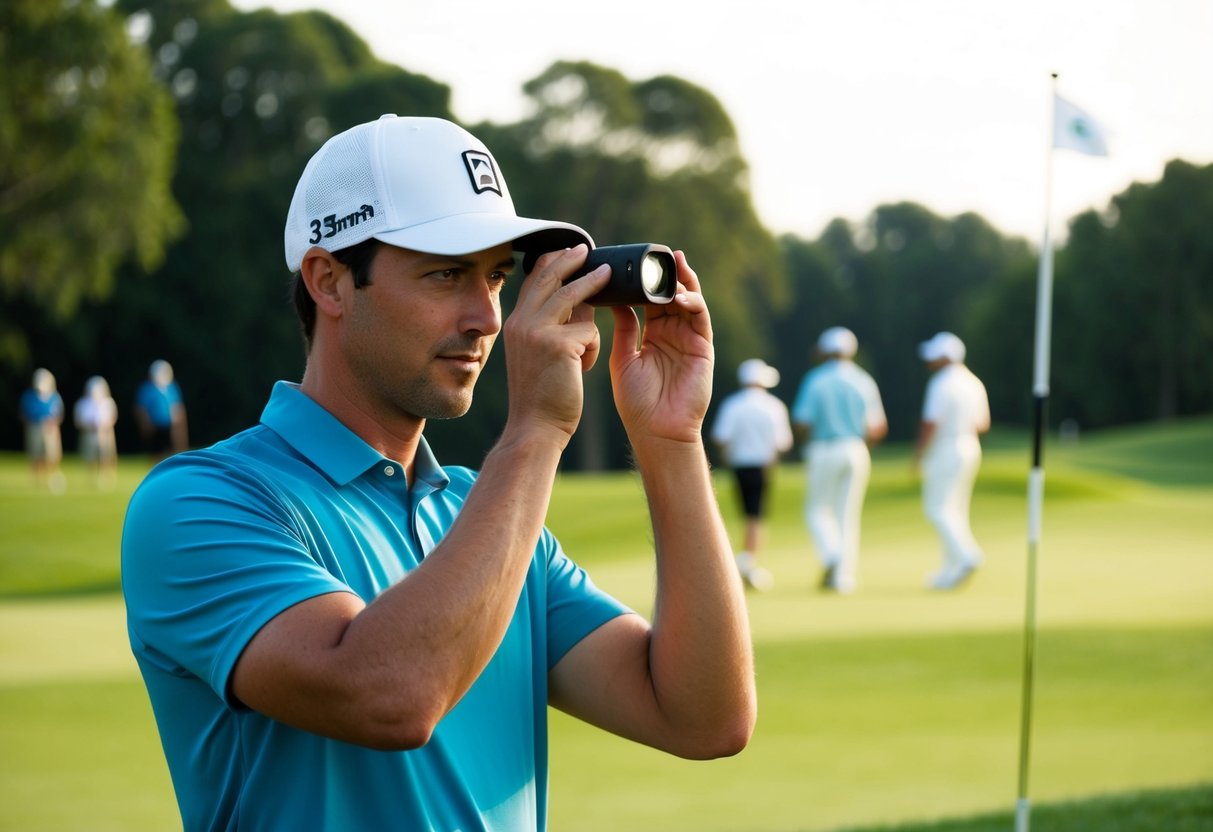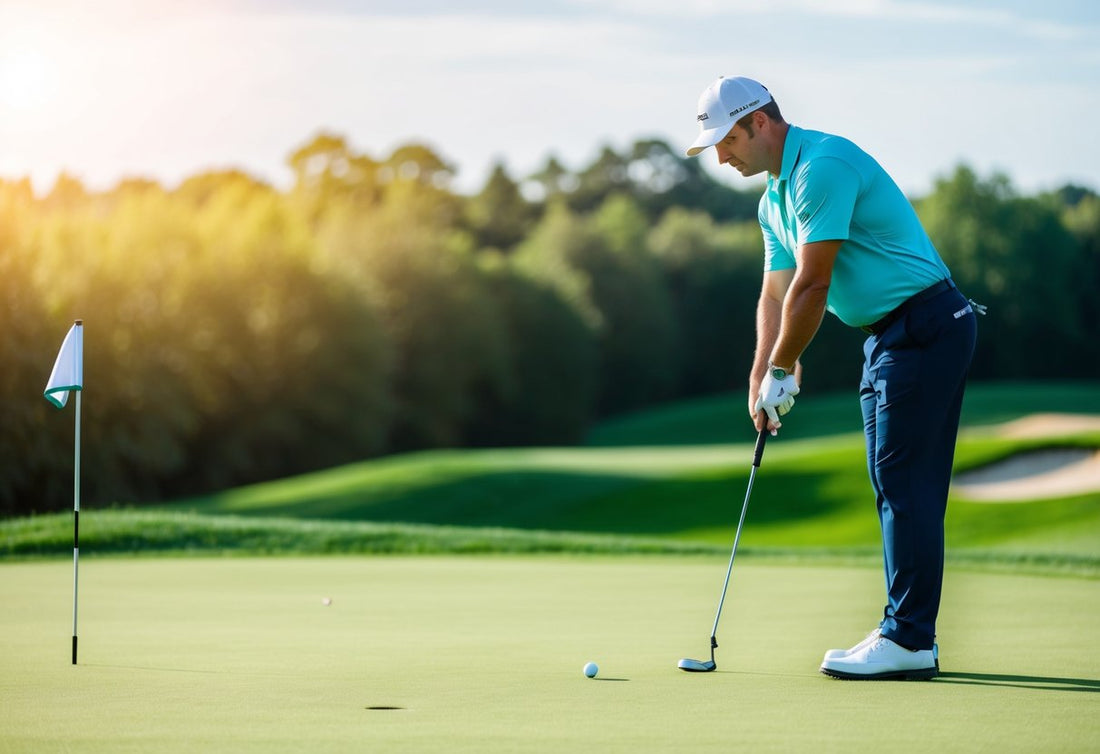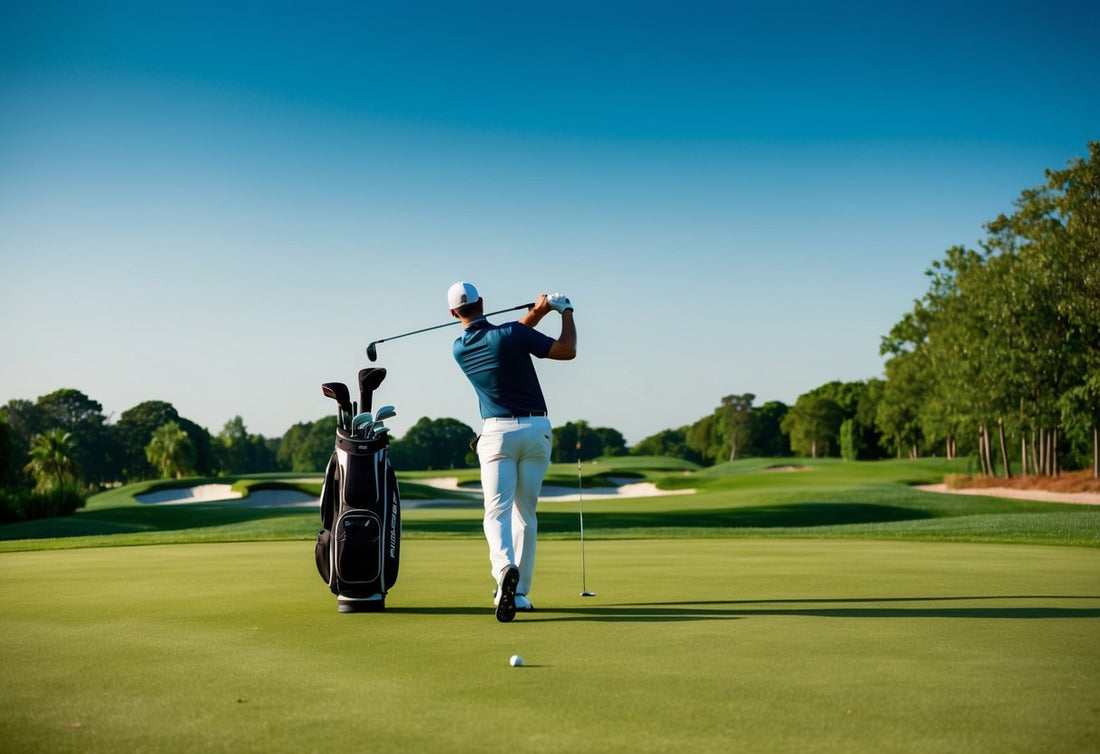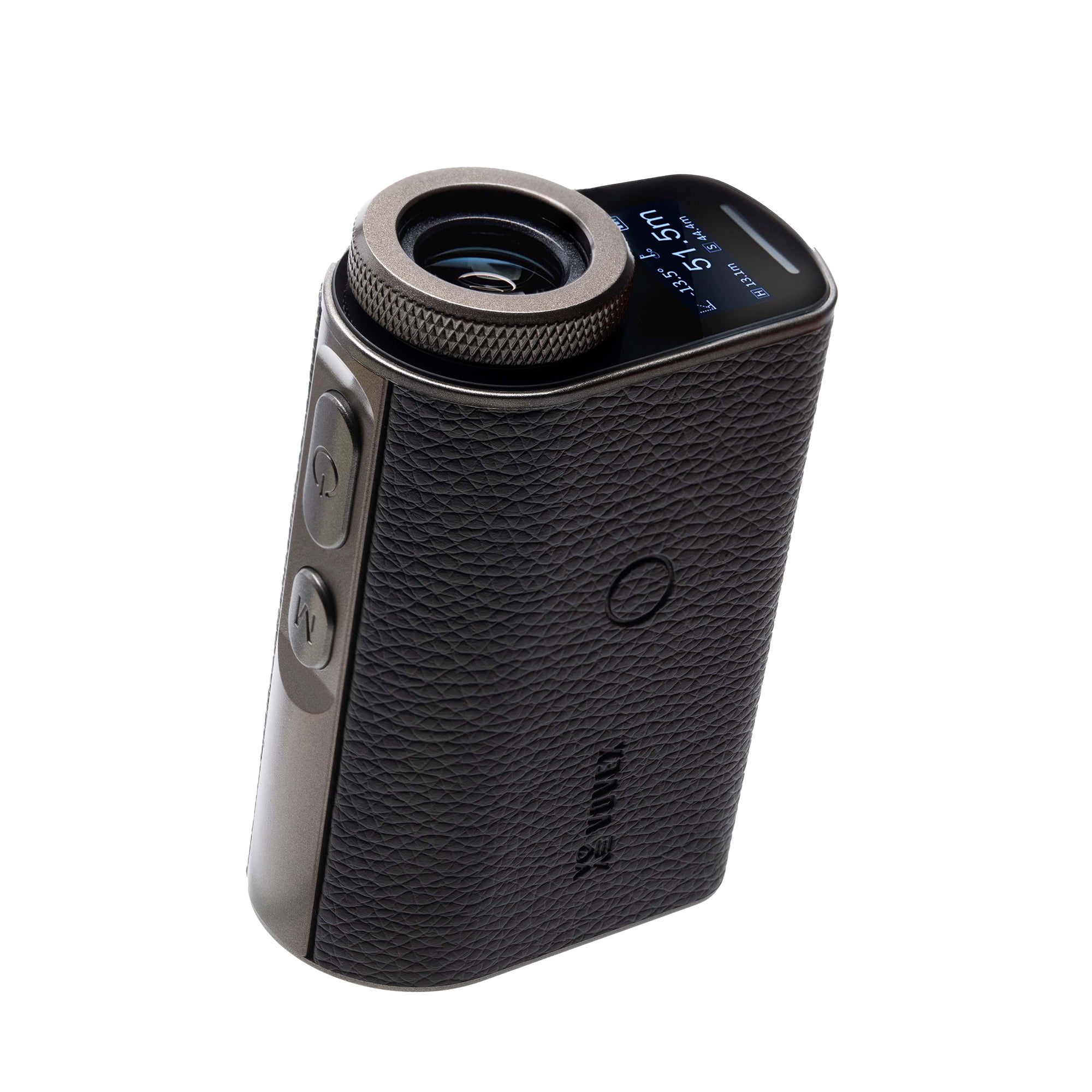Check out our golf rangefinders by Vovex to elevate your game!
Golf rangefinders have revolutionized the way we approach distance management on the course, but using them properly is essential for maintaining good flow during a round. A golf rangefinder should be used quickly between shots while others are playing, with preparation done before it's your turn to hit. When used correctly, these devices actually speed up play by eliminating guesswork and reducing the time spent pacing off yardages or searching for sprinkler heads.
We've all been in groups where someone fumbles with their rangefinder while everyone waits, creating unnecessary delays and frustration. The key is developing a smooth routine that incorporates the rangefinder seamlessly into your pre-shot process. Most golfers can get accurate readings in under 10 seconds once they've practiced, making the device an asset rather than a hindrance to pace of play.
Key Takeaways
- Prepare your rangefinder before it's your turn to play to maintain pace and show respect for playing partners.
- Incorporate quick rangefinder checks into your pre-shot routine, aiming to complete readings in under 10 seconds.
- Modern rangefinders with slope and quick-lock features can further enhance efficiency when used properly during appropriate moments in play.
Understanding Golf Rangefinders
Golf rangefinders have revolutionized how we approach distance measurement on the course. These handy devices use laser technology or GPS to provide precise yardage to targets, helping golfers make more informed club selections.
Most rangefinders fall into two main categories: laser and GPS models. Laser rangefinders work by emitting a beam that bounces off your target and returns to the device. GPS versions rely on satellite technology to provide pre-mapped distances to various points on the course.
Key Features to Look For:
- Slope adjustment capability (tournament legal when disabled)
- Pin-seeking technology
- Magnification (typically 5x-7x)
- Vibration confirmation when target is acquired
- Water resistance
The accuracy of modern rangefinders is impressive, with most laser models providing distances within 1 yard of accuracy. GPS units typically offer readings within 3-5 yards of precision.
We've found that rangefinders with "jolt" or vibration technology are particularly helpful, as they confirm when you've locked onto the flagstick rather than objects behind it. This feature alone can save valuable time during your round.
Battery life varies widely between models. Laser rangefinders typically operate on CR2 batteries lasting 2-3 months of regular play, while GPS units generally need recharging after 1-2 rounds.
Legal tournament play allows rangefinders without slope functionality enabled. Always check local rules before competition to ensure your device is compliant.
Essential Rangefinder Etiquette
Using a rangefinder on the golf course can be incredibly helpful, but only when done with consideration for other players. We've found that proper rangefinder etiquette is essential for maintaining pace of play and respecting fellow golfers.
Be ready when it's your turn. Have your rangefinder accessible—hanging from your bag or in an easily reachable pocket—so you're not fumbling around when it's time to make your shot.
Pre-plan your rangefinder use. While others are taking their shots, you can quietly take your measurements without disturbing them. This parallel processing saves valuable minutes throughout your round.
Keep your measurements quick. Most modern rangefinders give readings in seconds. If yours takes longer, consider upgrading to maintain good pace of play.
Silence is golden! Make sure your device is on silent mode—nobody wants to hear electronic beeping during their backswing.
Here's a simple checklist for rangefinder courtesy:
- Take measurements when others are preparing their shots
- Keep device on silent mode
- Have rangefinder readily accessible
- Limit measurement time to 5-10 seconds
- Put it away immediately after use
Never share readings unless asked. While it might seem helpful, offering unsolicited distance information can be distracting to players who prefer their own assessment methods.
We've noticed rangefinders are most efficient when used selectively. Focus on shots where precision matters most—approaches to greens and hazard clearances—rather than measuring every single shot.
Pre-Round Preparation
Preparing your rangefinder before teeing off can save precious minutes during your round. We recommend charging your device fully the night before play and installing fresh batteries if your model requires them.
Morning Routine Checklist:
- Clean the lens with a microfiber cloth
- Check battery level
- Adjust settings to your preferences
- Attach to your bag or belt for easy access
Familiarize yourself with your specific rangefinder model at home rather than on the course. This prevents the awkward fumbling that can frustrate playing partners and groups behind you.
Practice retrieving your rangefinder quickly from wherever you plan to store it during play. A dedicated pocket in your golf bag or a belt clip works well for most golfers.
Pre-set your most commonly used features before arriving at the course. For most players, this means configuring slope adjustments (where permitted) and preferred measurement units.
Many modern rangefinders include course-specific features. We suggest downloading relevant course information before your round if your device offers this capability.
Consider marking your device with distinctive tape or a personalized sticker. This helps identify your rangefinder quickly and prevents mix-ups with similar-looking devices in your group.
Using Your Rangefinder Effectively
Mastering rangefinder technique can transform your pace of play while still providing accurate distance readings. The key lies in quick activation, efficient targeting, and rapid distance interpretation.
Quick Activation
Most modern rangefinders feature quick-start functionality that we recommend learning thoroughly. Keep your device in an accessible pocket or attached to your bag where you can grab it without searching. Many golfers find attaching it to their pushcart or using a magnetic mount speeds up access considerably.
When approaching your ball, power up your rangefinder while walking rather than waiting until you stop. Many models now wake from sleep mode almost instantly with a single button press.
We've found that holding the rangefinder in your non-dominant hand works best, allowing you to maintain your grip on the club with your dominant hand. This small adjustment saves precious seconds on every measurement.
Efficient Targeting Techniques
Target the largest part of the flagstick rather than trying to pinpoint the very top or bottom. The middle section offers the largest visual profile and typically returns readings faster.
For rangefinders with slope technology, take your reading from a stable position. Slight movements can affect the slope calculation and force you to remeasure.
Pre-scan larger targets like bunkers or greens while your playing partners are hitting. This gives you general distances before it's your turn to play.
Use the scan mode (available on most models) when unsure of hazard distances. It allows continuous measurement as you pan across the landscape, identifying multiple reference points quickly.
Understanding Distances Fast
We recommend memorizing your typical distances for each club rather than consulting a notecard after each reading. This immediate mental conversion from yardage to club selection dramatically speeds up play.
Consider creating mental "zones" for your clubs: knowing that 100-110 yards equals your gap wedge eliminates decision fatigue on the course.
When conditions affect ball flight, apply your standard adjustments quickly. For instance, if you typically add one club for uphill shots, make this calculation immediately after getting your reading.
Practice interpreting readings that fall between your standard club distances. Being comfortable with partial swings or "in-between" clubs prevents lengthy deliberation when you're between your 7 and 8 iron distances.
Incorporating Rangefinders Into Routine Play
Seamless integration of rangefinders into your golf routine requires practice and consideration for both pace of play and fellow golfers. A well-used rangefinder can enhance precision without disrupting the flow of the game.
Sharing Rangefinder Information
Offering distance readings to playing partners shows excellent golf etiquette. When you've taken a measurement, briefly announce the yardage to the group with a simple "It's 157 to the pin" or "178 to clear the bunker." This small courtesy eliminates duplicate readings and speeds up play for everyone.
Don't volunteer complex information unless requested. Some players prefer making their own distance judgments, so be respectful of their process.
For regular playing groups, establish a rotation where one person handles distance measurements on each hole. This system can cut several minutes from your round while building camaraderie among players.
Rangefinder Use During Tournaments
Tournament play has specific rangefinder rules that vary by organization. PGA Tour events now permit basic distance-measuring devices but prohibit slope-adjusted readings. Always check the local tournament rules before your round.
When competing, prepare your rangefinder measurements while others are hitting. This preparation ensures you're ready when it's your turn without delaying play.
Keep your device easily accessible in a dedicated pocket or attached to your bag. We've found that players who fumble through multiple pockets searching for their rangefinder can add unnecessary minutes to each hole.
Many competitive golfers mark yardages in their yardage books during practice rounds, providing a backup if battery issues occur.
When To Avoid Rangefinder Use
Skip the rangefinder when it's obvious you're facing a short chip or when playing casual rounds where precise yardage isn't critical. On busy courses with groups waiting behind you, rely more on course markings and less on precise measurements.
During inclement weather, using a rangefinder may be impractical. Rain and fog can interfere with laser readings and potentially damage your device.
Don't use your rangefinder when another player is addressing their ball or preparing to hit. The movement can be distracting and breaks an unwritten rule of golf etiquette.
If you're new to rangefinders, practice using yours at the driving range first. This preparation helps develop the quick, efficient technique that won't slow down your foursome during actual play.
Common Courtesy on the Course
Using a rangefinder on the golf course is a privilege that comes with responsibility. We believe that respecting other players is just as important as knowing the exact yardage to the pin.
Pre-shot preparation is key to maintaining pace of play. Have your rangefinder ready before it's your turn to hit, not when everyone is waiting on you.
When using your device, stand still and away from other players' line of sight. Nothing is more distracting than someone fidgeting with a rangefinder in your peripheral vision during your backswing.
Keep conversations about readings brief. While it's fine to share distance information with playing partners, avoid lengthy discussions about every yard and slope percentage.
Consider these quick etiquette tips:
- Put away your rangefinder immediately after use
- Silence all beeps and sounds
- Never point lasers directly at other golfers
- Stay aware of your group's position relative to others on the course
We've found that properly using a rangefinder can actually speed up play when done correctly. Knowing precise distances eliminates guesswork and reduces the time spent debating club selection.
On busy days, be extra mindful of your timing. If the course is packed, streamline your routine even further to keep things moving.
Remember that not all players use rangefinders, and some prefer traditional methods. Respect different approaches to the game and avoid pushing technology on those who prefer to play without it.
Advanced Rangefinder Features and Best Practices
Modern golf rangefinders offer sophisticated capabilities that go well beyond basic distance measurements. These advanced features can significantly improve club selection decisions and overall performance when used properly.
Slope Calculation
Slope-enabled rangefinders measure elevation changes between your position and the target, adjusting the displayed distance accordingly. This feature is invaluable on hilly courses where playing uphill or downhill significantly affects club selection.
We've found that a shot playing 150 yards uphill might actually play like 165 yards, while the same distance downhill could play like 135 yards. Most slope rangefinders display both the actual distance and the "plays like" distance.
Important note: Turn off slope functionality during tournament play! It's illegal under USGA Rule 4.3 for competitive rounds.
The latest models include easy-to-use slope on/off switches with visible indicators to ensure compliance during official play. Some even feature magnetic faceplates that change color when tournament mode is activated.
Weather Conditions Adaptation
Premium rangefinders now incorporate barometric pressure, temperature, and humidity readings to calculate how environmental factors affect ball flight.
These models provide adjusted yardages based on current conditions. For example, cold air (below 60°F) increases resistance, reducing distance by approximately 2 yards per 10-degree drop below 70°F.
Similarly, high humidity actually helps the ball fly farther, while altitude gains add roughly 2% distance per 1,000 feet above sea level.
When using these features, we recommend:
- Taking multiple readings in changing weather
- Comparing adjusted vs. raw distances to develop feel
- Recalibrating when conditions shift significantly during your round
The best practice is to use these readings as guides rather than absolute values.
Course Mapping
Advanced rangefinders with GPS capabilities offer comprehensive course mapping features to enhance strategic play.
These devices store thousands of pre-loaded courses and provide:
- Front/middle/back green measurements
- Distances to hazards and layup spots
- Custom flagstick placement updates
- Shot tracking capabilities
The mapping features work best when you study the hole before playing. Take 30 seconds to review the layout and identify key positions for layups or carries over hazards.
We've found that combining laser precision for approach shots with GPS mapping for strategic decisions offers the best of both worlds. Many golfers now carry hybrid devices that incorporate both technologies in one unit.
To maximize efficiency, save detailed mapping reviews for when others in your group are hitting.
Maintaining Pace of Play
The golden rule of rangefinder use is simple: be prepared before it's your turn to play. We recommend having distance readings ready while others are hitting their shots. This preparation eliminates unnecessary delays when it's your turn.
Ready golf principles apply to rangefinder usage too. While your playing partner is setting up, you can discreetly check distances for your upcoming shot. Just be sure to remain still and silent during their actual swing.
Time-saving techniques:
- Pre-check distances while walking to your ball
- Limit yourself to one reading per shot (two maximum)
- Keep the device easily accessible in your pocket or attached to your bag
- Have a backup plan (like pre-marked sprinkler heads) if batteries fail
Remember that most courses expect 4-4.5 hours for a round of golf. Using a rangefinder efficiently can actually improve pace by eliminating guesswork and reducing poor club selections.
If you're playing with a slower group, consider alternating rangefinder duties. One player can get readings for nearby balls, sharing information to keep things moving smoothly.
We've found that practicing with your rangefinder at the driving range helps build speed and confidence. Try timing yourself to get readings in under 10 seconds - this skill transfers perfectly to the course.
Concluding Thoughts on Rangefinder Etiquette
Mastering rangefinder etiquette is essential for the modern golfer. When used properly, these devices enhance the game without disrupting its natural flow or frustrating your playing partners.
Pre-round preparation is key. We recommend setting up your rangefinder before reaching the first tee and familiarizing yourself with its functions during practice sessions.
Remember the golden rule: be ready when it's your turn. Having your rangefinder accessible (attached to your bag or cart) allows for quick distance readings without the dreaded pocket-digging delay.
Group awareness matters tremendously on the course. While you're waiting for others to play, take your measurements so you're prepared when your turn comes.
Common courtesy points to remember:
- Avoid pointing rangefinders at other players
- Keep beeping models silent in backswings
- Share readings when playing partners ask
- Put the device away promptly after use
We've seen technological improvements make rangefinders faster and easier to use, but the responsibility for efficient play remains with us golfers.
Incorporating these etiquette practices into your routine will help maintain pace of play while still benefiting from precise distance information. Your playing partners will appreciate your consideration, and you'll enjoy more pleasant rounds as a result.
Frequently Asked Questions
Golf rangefinders can significantly improve your game when used correctly. Here are answers to common questions about efficient rangefinder use that will help maintain pace of play.
What's the best way to quickly lock in on the flag using a rangefinder?
Pre-scan the general area before attempting to lock onto the flag. This gives you a reference distance and helps your rangefinder focus more quickly.
When targeting the flag, use both hands to stabilize the device and aim slightly below the flag first, then slowly move up. Most modern rangefinders have vibration or audio confirmation when they lock onto the flag.
Many golfers find success with the "box method" - scan in a small box pattern around where you think the flag is located rather than trying to hit it directly.
Can you share some tips for efficiently operating a golf rangefinder during a tournament?
Have your rangefinder accessible in your bag's side pocket or attached to your cart for quick retrieval. Don't wait until it's your turn to play to take measurements.
Take readings while others are hitting their shots, then put your device away immediately. This parallel processing keeps the game moving smoothly.
Know your device's features thoroughly before tournament day. Nothing slows play more than fumbling with settings or trying to figure out how your rangefinder works mid-round.
How can I practice using a rangefinder to ensure I don't hold up the game?
Practice at the driving range where you can take multiple readings to the same targets without pressure. Try to get readings within 5 seconds consistently.
Set up practice sessions during off-peak hours at your course. Work on quickly obtaining distances to various course features from multiple positions.
Time yourself during practice rounds to develop efficiency. Challenge yourself to get accurate readings in less time with each round.
Is there a preferred technique to stabilize a rangefinder for an accurate reading?
The best stance involves planting your feet shoulder-width apart with knees slightly bent. This provides a solid base for steady readings.
Use both hands in a cupping position, with elbows tucked into your sides for added stability. Some golfers rest the rangefinder against their cheek for an additional point of contact.
For extreme distances or windy conditions, consider using available structures like golf carts or trees to brace yourself or the rangefinder.
In what scenarios is it considered poor etiquette to use a rangefinder on the course?
Using a rangefinder when it's your turn to hit while others are waiting is universally considered poor form. Always do your distance work during downtime.
Repeatedly measuring the same shot because you don't trust your first reading frustrates playing partners and slows pace of play dramatically.
Measuring distances for other players without being asked can be intrusive. Let others request help if they need it rather than volunteering unsolicited information.
Are there any shortcuts or features on modern rangefinders that can speed up distance measuring?
Slope-enabled rangefinders (where permitted) provide adjusted distances accounting for elevation changes, eliminating the need for manual calculations.
Many newer models offer "scan mode" allowing you to pan across multiple targets quickly, getting readings as you move across the landscape.
Look for models with "priority modes" that automatically distinguish between foreground obstacles and the flagstick, reducing time spent trying to get the right target.






